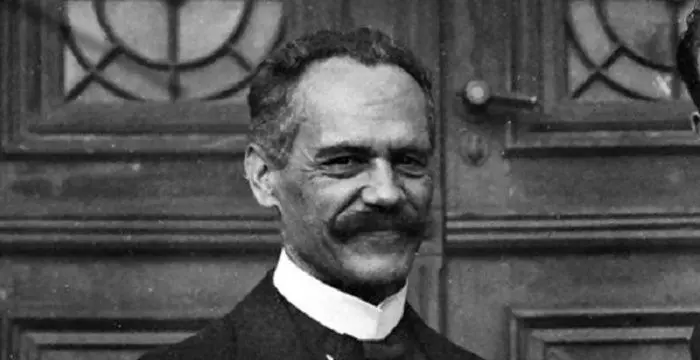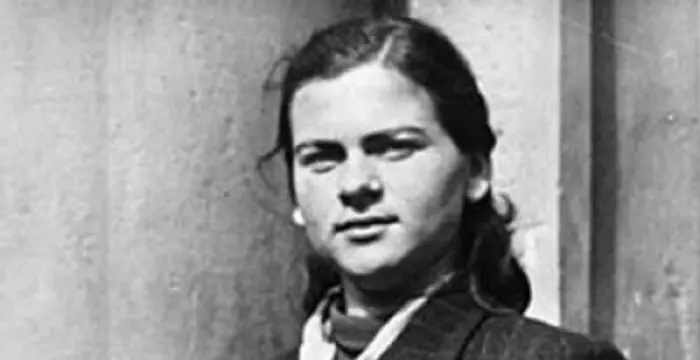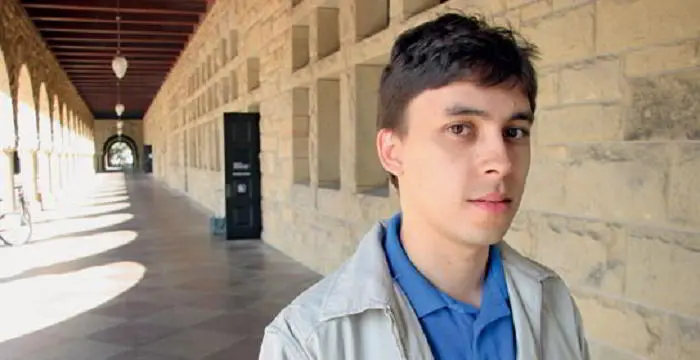
Arnold Sommerfeld - Scientists, Career and Facts
Arnold Sommerfeld's Personal Details
Arnold Sommerfeld was a theoretical physicist, who established the azimuthal and spin quantum numbers, and mathematical proof of X-ray wave theory
| Information | Detail |
|---|---|
| Birthday | December 5, 1868 |
| Died on | April 26, 1951 |
| Nationality | German |
| Famous | Scientists, Physicists |
| Universities |
|
| Cause of death |
|
| Birth Place | Königsberg |
| Gender | Male |
| Sun Sign | Sagittarius |
| Born in | Königsberg |
| Famous as | Physicist |
| Died at Age | 82 |
// Famous Physicists
Henry Cavendish
Henry Cavendish was a theoretical chemist and physicist, renowned for discovery of hydrogen and calculation of the mass of earth. To know more about his childhood, profile, timeline and career read on
Walter Kohn
Nobel Laureate Walter Kohn was an Austrian-born American theoretical chemist and physicist. Check out this biography to know about his childhood, life, achievements, works & timeline.
Nikola Tesla
Nikola Tesla was a Serbian-American inventor, best known for his development of alternating current electrical systems. This biography of Nikola Tesla provides detailed information about his childhood, life, achievements, works & timeline.
Arnold Sommerfeld's photo
Who is Arnold Sommerfeld?
Arnold Sommerfeld was a renowned German physicist who did pioneering work in the field of quantum physics. His work related to the X-ray wave theory and introduction of the azimuthal and spin quantum numbers to describe the unique quantum state of an atom were major breakthroughs in the field of atomic physics. As a child Sommerfeld was interested more in literature and history and it was unclear as to what course he should pursue further. Realization finally dawned onto him when he interacted with the great mathematical minds like David Hilbert, Adolf Hurwitz, and Ferdinand von Lindemann and he decided to pursue a career in exact sciences. This mathematician also completed a one year term in the defence forces and unlike his other contemporaries who disliked the military servitude, Sommerfeld engaged in voluntary military service time and again for the next eight years. His interaction with mathematician Felix Klein marked the beginning of a life-long professional collaboration and Klein was a major influence in shaping the course of Arnold’s career. This genius mind is credited with serving as the doctoral advisor for the most number of Nobel laureates in his teaching career spanning over three decades. Read on to know more about Sommerfeld’s contribution to the world of quantum physics
// Famous Scientists
Juliane Koepcke
Juliane Koepcke is a German-Peruvian biologist, who was the lone survivor among the 92 passengers and crew of the ill-fated LANSA Flight 508 that crashed in the Peruvian rainforest on 24 December 1971. Know more about her life in this biography.
Henry Cavendish
Henry Cavendish was a theoretical chemist and physicist, renowned for discovery of hydrogen and calculation of the mass of earth. To know more about his childhood, profile, timeline and career read on
Konstantin Tsiolkovsky
Konstantin Tsiolkovsky was a Russian rocket scientist and a pioneer of astronautics. This biography provides detailed information about his childhood, family, personal life, career, achievements, etc.
Childhood & Early Life
Arnold Sommerfeld was born, to parents Cäcile Matthias and Franz Sommerfeld, on 5 December 1868, in the East Prussian city of Königsberg. Franz who belonged to an affluent and influential family was a medical practitioner.
Sommerfeld attended High School at the ‘Altstädtisches Gymnasium’ in 1875; German physicist Wilhelm Wien and German mathematician Hermann Minkowski were his seniors at the school.
After completing his matriculation in 1886, he pursued higher education at the ‘University of Königsberg’. Though his primary interest was in studying mathematics he also engaged in courses such as natural sciences, philosophy, and political economy at the University.
It was under the tutelage of expert mathematicians like Hilbert, Hurwitz and Lindemann that Sommerfeld finally decided to conduct research on pure mathematics for his dissertation.
His thesis catered to Eigen functions and partial differential equations and was titled ‘Die willkürlichen Functionen in der mathematischen Physik’ (The arbitrary functions in mathematical physics). In 1891, this bright upcoming mathematician received a doctorate from the ‘University of Königsberg’.
Soon after, he underwent training to obtain a teaching diploma and after faring successfully in the examinations, he joined the military in 1892. During his one year term with the defence services he was posted at Königsberg with the ‘reserve regiment’.
Career
Sommerfeld moved to Gottingen in 1893, as it was where many of the great mathematical minds resided and thus the town had evolved as "the core of mathematical development" in Germany. To earn a living, this budding mathematician then took up the job of an assistant at the ‘Mineralogical Institute’.
In Gottingen, Arnold had the opportunity to make an acquaintance with the renowned German mathematician Felix Klein, who was known for his work on complex analysis and non-Euclidean geometry.
Klein eventually accepted Sommerfeld as his apprentice and following in the footsteps of the eminent mathematician, this emerging genius produced his second work. The discourse on ‘mathematical theory of diffraction’ also involved partial differential equations.
In further continuation to his work on ‘mathematical theory of diffraction’, this brilliant mathematician conducted his own research and submitted his thesis. His research work qualified for achieving the highest academic qualification in the country and he was designated as a ‘Privatdozent’ in 1895. This academic honour bestowed upon him allowed him to teach at University level.
Starting in 1895-96, Klein and Sommerfeld began a 13 year long mathematical alliance, which resulted in a four volume text ‘Die Theorie des Kreisels’. The compilation dealt with theory of rotating bodies and application of mathematical theory to geophysics, astronomy and technology.
Owing to financial difficulties he took up a less lucrative assignment of mathematics professor at the ‘Mining Academy’ in Clausthal starting in October 1987. Though the job was appealing to his intellect but it provided him with means to sustain his family and he could also continue his correspondence with Klein from Clausthal.
The mathematics professor then took up a job of teaching mechanics at ‘RWTH Aachen University’, previously known as the ‘Königliche Technische Hochschule Aachen’.
In 1901, Sommerfeld, along with other mathematicians, undertook the task of editing the fifth volume of ‘Mathematical Encyclopaedia’ (Encyklopädie der mathematischen Wissenschaften) at the insistence of Felix Klein.
He then moved to Munich in 1906 and was appointed as ordinarius professor of physics at the ‘University of Munich’. Wilhelm Röntgen, who was the then Director of Physics Institute at Munich suggested Sommerfeld’s name for the position of director at the new ‘Theoretical Physics Institute’, affiliated to the University.
This exceptional mind then focussed on proving the X-ray wave theory, according to which X-rays were actually waves, using crystals as means of diffraction. He also worked to derive the mathematical proof of Albert Einstein’s theory of relativity.
Beginning in 1911, Arnold began work on, his most significant contribution to the world of science, in the field of Quantum theory. He proposed a modification to the Bohr’s atomic model wherein he stated the electrons revolve around the nucleus in elliptical orbits instead of the circular orbits as proposed in the original theory.
He helped in establishing the ‘Sommerfeld–Wilson quantization rules’ in 1915 and a year later he developed the ‘Sommerfeld Fine-structure constant’, which is an indicator of strength of the electromagnetic interaction between elementary charged particles.
In 1916 he propounded the concept of ‘Magnetic Quantum Number’ and four years later he discovered the ‘Inner Quantum Number’.
The eminent quantum physicist then collaborated with contemporary Walther Kossel and the duo came up with the Sommerfeld–Kossel displacement law in 1919.
In 1918, Sommerfeld came up with a new journal after assuming the chair at the ‘Deutsche Physikalische Gesellschaft’, which is one of the world’s largest organization of physicists. ‘Zeitschrift für Physik’ an offshoot of the journal was established two years later wherein upcoming scientists could submit their research work for publishing.
During the academic session 1922-23, this eminent physicist was invited to the ‘University of Wisconsin–Madison’ for delivering the ‘Carl Schurz Memorial Professor of Physics’ lectures.
Sommerfeld then applied statistical mechanics to refine the ‘Paul Drude model’ of electrons in metals in 1927 and the redefined version was named as ‘Drude-Sommerfeld model’.
The exceptional and pioneering physicist was honoured by the ‘University of Munich’ when they bestowed upon him the title of an emeritus professor on 1 April 1935.
From 1943-1950 he authored number of books such as ‘Mechanik – Vorlesungen über theoretische Physik Band 1’, ‘Mechanik der deformierbaren Medien – Vorlesungen über theoretische Physik Band 2’, ‘Elektrodynamik – Vorlesungen über theoretische Physik Band 3’, ‘Optik – Vorlesungen über theoretische Physik Band 4’, ‘Thermodynamik und Statistik – Vorlesungen über theoretische Physik Band 5’ and ‘Partielle Differentialgleichungen der Physik – Vorlesungen über theoretische Physik Band 6’.
Awards & Achievements
This eminent scientist was conferred with many awards and honours throughout his life. He was a member of the prestigious ‘Royal Society of London’, ‘Indian Academy of Sciences’, ‘Russian Academy of Sciences’ and the ‘United States National Academy of Sciences’.
He had received honorary degrees from the Universities of Athens, Calcutta, Rostock and Aachen.
The famous physicist was honoured with the ‘Max-Palnck Medal’, ‘Lorentz Medal’ and the ‘Oersted Medal’ for his outstanding contribution to the world of physics.
Personal Life & Legacy
During his stay at Gottingen, Arnold took a liking to Johanna Höpfner, but his financial condition proved a hindrance and he was deemed unsuitable for Johanna. Thus Sommerfeld took up a high paying job of mathematics professor in Clausthal. Johanna and Arnold then entered the wedlock and they were blessed with four children.
The pioneering scientist lost his life in a road accident on 26 April 1951 while he was out on a stroll with his grandchildren.
This famous scientist is the eponym for the ‘Center of Theoretical Physics’ in the University of Munich.
Trivia
Though he was nominated for the Nobel Prize, the most number of times than any other physicist, this eminent scientist never received the award
// Famous Sagittarius Celebrities peoples
Billie Eilish
Billie Eilish Pirate Baird O’Connell is an American singer and songwriter. Check out this biography to know about her childhood, family, personal life, birthday, etc.
Jacelyn Reeves
Jacelyn Reeves is a former flight attendant who once had a fling with Clint Eastwood. Check out this biography to know about her birthday, childhood, family life, achievements and fun facts about her.
Edmund Kemper
Edmund Kemper is a convicted serial killer from America who murdered ten people. Check out this biography to know about his childhood, life, crimes and other facts about him.
Arnold Sommerfeld's awards
| Year | Name | Award |
|---|---|---|
Other | ||
| 0 | 1931 - Max Planck Medal | |
| 0 | 1939 - Lorentz Medal | |
Arnold Sommerfeld biography timelines
- // 5th Dec 1868Arnold Sommerfeld was born, to parents Cäcile Matthias and Franz Sommerfeld, on 5 December 1868, in the East Prussian city of Königsberg. Franz who belonged to an affluent and influential family was a medical practitioner.
- // 1875Sommerfeld attended High School at the ‘Altstädtisches Gymnasium’ in 1875; German physicist Wilhelm Wien and German mathematician Hermann Minkowski were his seniors at the school.
- // 1886After completing his matriculation in 1886, he pursued higher education at the ‘University of Königsberg’. Though his primary interest was in studying mathematics he also engaged in courses such as natural sciences, philosophy, and political economy at the University.
- // 1891His thesis catered to Eigen functions and partial differential equations and was titled ‘Die willkürlichen Functionen in der mathematischen Physik’ (The arbitrary functions in mathematical physics). In 1891, this bright upcoming mathematician received a doctorate from the ‘University of Königsberg’.
- // 1892Soon after, he underwent training to obtain a teaching diploma and after faring successfully in the examinations, he joined the military in 1892. During his one year term with the defence services he was posted at Königsberg with the ‘reserve regiment’.
- // 1893Sommerfeld moved to Gottingen in 1893, as it was where many of the great mathematical minds resided and thus the town had evolved as "the core of mathematical development" in Germany. To earn a living, this budding mathematician then took up the job of an assistant at the ‘Mineralogical Institute’.
- // 1895In further continuation to his work on ‘mathematical theory of diffraction’, this brilliant mathematician conducted his own research and submitted his thesis. His research work qualified for achieving the highest academic qualification in the country and he was designated as a ‘Privatdozent’ in 1895. This academic honour bestowed upon him allowed him to teach at University level.
- // 1895Starting in 1895-96, Klein and Sommerfeld began a 13 year long mathematical alliance, which resulted in a four volume text ‘Die Theorie des Kreisels’. The compilation dealt with theory of rotating bodies and application of mathematical theory to geophysics, astronomy and technology.
- // 1901In 1901, Sommerfeld, along with other mathematicians, undertook the task of editing the fifth volume of ‘Mathematical Encyclopaedia’ (Encyklopädie der mathematischen Wissenschaften) at the insistence of Felix Klein.
- // 1906He then moved to Munich in 1906 and was appointed as ordinarius professor of physics at the ‘University of Munich’. Wilhelm Röntgen, who was the then Director of Physics Institute at Munich suggested Sommerfeld’s name for the position of director at the new ‘Theoretical Physics Institute’, affiliated to the University.
- // 1911Beginning in 1911, Arnold began work on, his most significant contribution to the world of science, in the field of Quantum theory. He proposed a modification to the Bohr’s atomic model wherein he stated the electrons revolve around the nucleus in elliptical orbits instead of the circular orbits as proposed in the original theory.
- // 1915He helped in establishing the ‘Sommerfeld–Wilson quantization rules’ in 1915 and a year later he developed the ‘Sommerfeld Fine-structure constant’, which is an indicator of strength of the electromagnetic interaction between elementary charged particles.
- // 1916In 1916 he propounded the concept of ‘Magnetic Quantum Number’ and four years later he discovered the ‘Inner Quantum Number’.
- // 1918In 1918, Sommerfeld came up with a new journal after assuming the chair at the ‘Deutsche Physikalische Gesellschaft’, which is one of the world’s largest organization of physicists. ‘Zeitschrift für Physik’ an offshoot of the journal was established two years later wherein upcoming scientists could submit their research work for publishing.
- // 1919The eminent quantum physicist then collaborated with contemporary Walther Kossel and the duo came up with the Sommerfeld–Kossel displacement law in 1919.
- // 1922During the academic session 1922-23, this eminent physicist was invited to the ‘University of Wisconsin–Madison’ for delivering the ‘Carl Schurz Memorial Professor of Physics’ lectures.
- // 1927Sommerfeld then applied statistical mechanics to refine the ‘Paul Drude model’ of electrons in metals in 1927 and the redefined version was named as ‘Drude-Sommerfeld model’.
- // 1st Apr 1935The exceptional and pioneering physicist was honoured by the ‘University of Munich’ when they bestowed upon him the title of an emeritus professor on 1 April 1935.
- // 1943 To 1950From 1943-1950 he authored number of books such as ‘Mechanik – Vorlesungen über theoretische Physik Band 1’, ‘Mechanik der deformierbaren Medien – Vorlesungen über theoretische Physik Band 2’, ‘Elektrodynamik – Vorlesungen über theoretische Physik Band 3’, ‘Optik – Vorlesungen über theoretische Physik Band 4’, ‘Thermodynamik und Statistik – Vorlesungen über theoretische Physik Band 5’ and ‘Partielle Differentialgleichungen der Physik – Vorlesungen über theoretische Physik Band 6’.
- // 26th Apr 1951The pioneering scientist lost his life in a road accident on 26 April 1951 while he was out on a stroll with his grandchildren.
// Famous German peoples
Jordan Carver
Jordan Carver is a famous German model. Let’s take a close look at her personal life, including her age, career, net worth, achievements and some fun facts.
Jürgen Klopp
Jürgen Klopp is a German football manager, and a former professional football player. Check out this biography to know more about his childhood, family, personal life, etc.
Irma Grese
Irma Grese was a notorious German Nazi concentration camp guard during the Second World War. This biography profiles her childhood, life, horrifying acts, death and other facts.
Juliane Koepcke
Juliane Koepcke is a German-Peruvian biologist, who was the lone survivor among the 92 passengers and crew of the ill-fated LANSA Flight 508 that crashed in the Peruvian rainforest on 24 December 1971. Know more about her life in this biography.
Jawed Karim
Jawed Karim is a German-American internet entrepreneur, technologist and co-founder of the video-sharing website, YouTube. Check out this biography to know about his childhood, family, personal life, achievements, age, etc.
Charles Bukowski
Charles Bukowski was a German-born American novelist, short story writer and poet. With this biography, learn in details about his childhood, life, works, career and timeline
Arnold Sommerfeld's FAQ
What is Arnold Sommerfeld birthday?
Arnold Sommerfeld was born at 1868-12-05
When was Arnold Sommerfeld died?
Arnold Sommerfeld was died at 1951-04-26
Where was Arnold Sommerfeld died?
Arnold Sommerfeld was died in Munich
Which age was Arnold Sommerfeld died?
Arnold Sommerfeld was died at age 82
Where is Arnold Sommerfeld's birth place?
Arnold Sommerfeld was born in Königsberg
What is Arnold Sommerfeld nationalities?
Arnold Sommerfeld's nationalities is German
What was Arnold Sommerfeld universities?
Arnold Sommerfeld studied at University of Königsberg
What is Arnold Sommerfeld's cause of dead?
Arnold Sommerfeld dead because of Accident
What is Arnold Sommerfeld's sun sign?
Arnold Sommerfeld is Sagittarius
How famous is Arnold Sommerfeld?
Arnold Sommerfeld is famouse as Physicist













